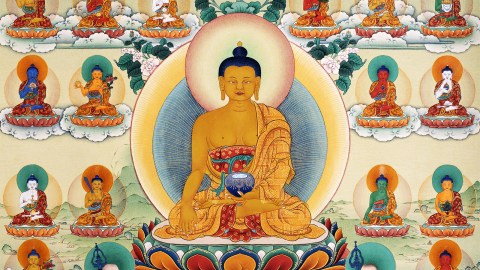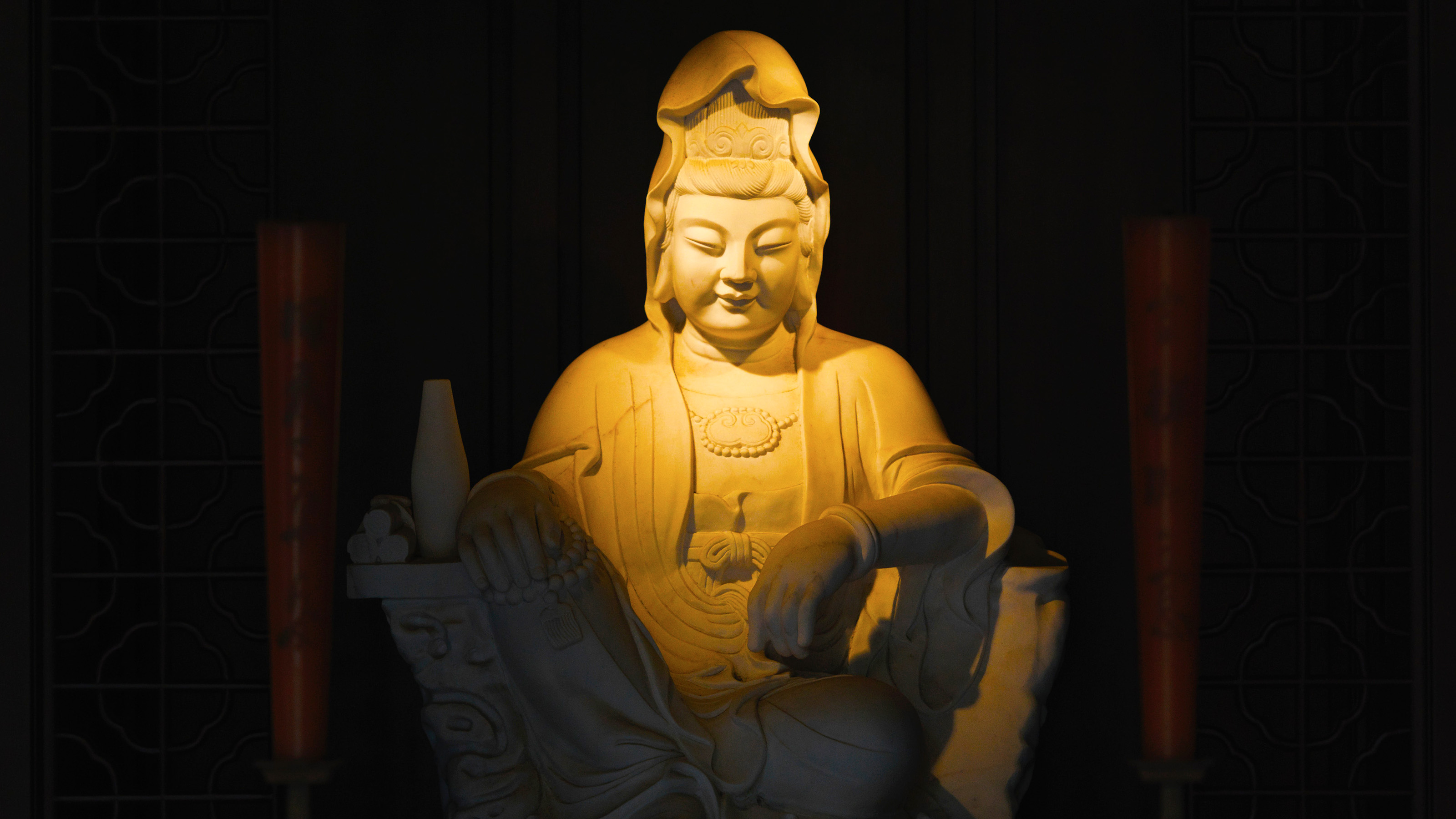An essential introduction to Buddhism in 8 profound quotes

- Buddhism is an ancient and popular religion that offers a path out of suffering.
- The founder of the religion — "The Buddha" — left behind a trove of parables and lessons.
- These succinct teachings can help anyone, regardless of creed or belief, lead a life with less suffering.
Buddhism is the world’s fifth largest religion. It dates back to the 5th century BC. Based on the teachings of Siddhartha Gautama, known as “The Buddha,” Buddhism teaches a path away from suffering, based on meditation, virtuous behavior, and spiritual development.
Here, we explore the foundational ideas of Buddhism by looking at cornerstone quotes from the Buddha himself. While he is not the only notable guide to the religion, his teachings remain at the core of one the most influential sets of ideas in human history. Beyond that, they represent useful tools to navigate suffering, regardless of creed or belief.
The Four Noble Truths
One: Suffering exists. Life is suffering. Suffering is real and universal. Suffering has many causes: loss, sickness, pain, failure, and the impermanence of pleasure.
Two: There is a cause of suffering. Suffering is due to attachment. It is the desire to have and control things. It can take many forms: craving of sensual pleasures; the desire for fame; the desire to avoid unpleasant sensations, like fear, anger, or jealousy.
Three: There is an end to suffering. Attachment can be overcome. Suffering ceases with the final liberation of Nirvana. The mind experiences complete freedom, liberation, and non-attachment. It lets go of any desire or craving.
Four: In order to end suffering, follow the Eightfold Path.
The fundamentals of Buddhism are to be found in the Buddha’s first sermon. In it, he expounded the “Four Noble Truths.” These explain that suffering is inherent to life; that it is caused by attachment, desire, and delusion; that these things can be overcome; and that there is a prescribed way to overcome them.
While this can seem pessimistic — the whole thing is popularly summarized as “life is suffering” — Buddhists tend to see it more as an accurate diagnosis of “life necessarily involves suffering” rather than a nihilistic statement that “life is nothing but misery.” Importantly, the third truth is that there is a way past suffering. That route away from suffering and toward nirvana — a difficult-to-capture idea of the state beyond the cycle of suffering and reincarnation — is the primary focus of millions of Buddhists.
The parable of the poisoned arrow
A man approached the Blessed One and wanted to have all his philosophical questions answered before he would practice. In response, the Buddha said, “It is as if a man who had been wounded by a poisoned arrow and when attended to by a physician were to say, ‘I will not allow you to remove this arrow until I have learned the caste, the age, the occupation, the birthplace, and the motivation of the person who wounded me.’ That man would die before having learned all this. In exactly the same way, anyone who should say ‘I will not follow the teaching of the Blessed One until the Blessed One has explained all the multiform truths of the world’ — that person would die before the Buddha had explained all this.”
While believing in doctrines of karma, rebirth, and other possible planes to be reborn into, the Buddha did not comment on many of the metaphysical issues other religious leaders consider important. A whole set of them is known as “the unanswerable questions” and includes things like whether the universe is infinite in space and time. The Buddha suggested that spending time on these subjects hindered progress toward nirvana. Instead, he repeated that his focus was on the problem of suffering as humanity encounters it here and now. He once said, “Whether the world is finite or infinite, limited or unlimited, the problem of your liberation remains the same.”
This is not to say that all schools of Buddhism have avoided these topics. As a diverse religion, there are Buddhist schools with all manner of gods, demons, celestial hosts, and well-described hells, along with thoughts on a whole host of metaphysical questions.
The parable of the lute
The Buddha said to the venerable Sona, “Sona, did not this thought arise in your mind, ‘Of the followers of the Blessed One who are most energetic, I am one. Yet, my mind has not yet found freedom?’”
“Yes, Lord.”
“Tell me, Sona, in earlier days were you not skilled in playing the lute?”
“Yes, Lord.”
“And tell me, Sona, when the strings of your lute were too taut, was then your lute tuneful and easily playable?”
“Certainly not, Lord.”
“And when the strings of your lute were too loose, was then your lute tuneful and easily playable?”
“Certainly not, Lord.”
“But when, Sona, the strings of your lute were neither too taut nor too loose, but adjusted to an even pitch, did your lute then have a wonderful sound and was easily playable?”
“Certainly, Lord”
Buddhism is known as “The Middle Way.” In this parable, the Buddha instructs a student on how to apply his focus best: not too much or too little. Just as this student needs a balanced approach, the Buddha argued for an even-keeled system for reaching freedom from suffering.
In the story of the Buddha’s life, he only found the path to enlightenment after trying and dismissing both indulgence in worldly pleasures and their total denial. It was only in the middle route that the freedom from suffering was to be found. As a result, Buddhist ethics, especially for lay practitioners, veer away from extremes. According to Dr. Peter Harvey, Buddhist ethics tend to lack “oughts,” be tailored toward the practitioner’s level of dedication, and come with a built-in warning against being too hardline on the virtues.
The Kalama Sutta
Do not go by revelation;
Do not go by tradition;
Do not go by hearsay;
Do not go on the authority of sacred texts;
Do not go on the grounds of pure logic;
Do not go by a view that seems rational;
Do not go by reflecting on mere appearances;
Do not go along with a considered view because you agree with it;
Do not go along on the grounds that the person is competent;
Do not go along because “the recluse is our teacher.”
Kalamas, when you yourselves know: These things are unwholesome, these things are blameworthy; these things are censured by the wise; and when undertaken and observed, these things lead to harm and ill, abandon them.
Kalamas, when you know for yourselves: These things are wholesome; these things are not blameworthy; these things are praised by the wise; undertaken and observed, these things lead to benefit and happiness, having undertaken them, abide in them.
In this sermon, given by the Buddha to the Kalama clan and known as the Kalama Sutta or the “charter of free inquiry,” the Buddha argues against several common logical fallacies in the search for truth. It is important to note that he does not advocate using sound logic alone to find “the truth.” Instead, the Buddha argues for accepting a truth only after it has been tested and found to lead to wholesome outcomes while avoiding vice and dogmatic approaches to understanding. This popular misinterpretation can make the Buddha appear more skeptical or inclined toward modern scientific thinking than his quotes support.
This sutta (or scripture), while famous, is part of a larger story. The next quote is a sermon on why one should strive to be moral and virtuous even if karma and reincarnation don’t exist — a Buddhist version of Pascal’s Wager. (You can read the whole thing here.)
Dependent arising
“All formations are transient; all formations are subject to suffering; all things are without a self. Therefore, whatever there be of form, of feeling, of perception, mental formations, or consciousness, whether past, present, or future, one’s own or external, gross or subtle, lofty or low, far or near, one should understand according to reality and true wisdom: ‘This does not belong to me; this am I not; this is not my Self.’”
A key teaching of Buddhism is the idea of “dependent arising” — it is one of the few tenets that every school of Buddhism agrees on. This maintains that everything is devoid of inherent existence. Everything that exists is caused by something else and will cause other things. Nothing is independent; every phenomenon depends on something else. Metaphysically speaking, nothing has an independent essence and can exist in perpetuity. This also means that when you try to find your “self,” there is no single, enduring, isolated thing to point to.
Buddhism teaches that a great deal of the suffering in our lives comes from the idea that things are permanent, unchanging, and unconnected to everything else. The doctrine of “dependent arising” teaches that everything is in flux, that nothing is permanent, and that even we aren’t as enduring as we might like to think.
The parable of the raft
“Monks, I will teach you the parable of the raft — for getting across, not retaining. It is like a man who is going on a journey and sees a great stretch of water, the near bank with dangers and fears, the farther bank secure and without fears, but there is neither a boat for crossing over, nor a bridge across. It occurs to him that to cross over he should fashion a raft out of sticks and branches. When he has crossed over to safety it occurs to him that the raft has been very useful and he wonders if he ought to take it with him. What do you think, monks? That the man is doing what should be done with the raft?
“No, lord.”
“What should the man do, monks? When he has crossed over to the beyond he must leave the raft and proceed on his journey. Monks, a man doing this would be doing what should be done with the raft. In this way I have taught you Dharma, like the raft, for getting across, not for retaining. You monks, by understanding the parable, must not cling to the right states of mind and, all the more, to the wrong states of mind.”
In this sermon, the Buddha reveals the Dharma as a tool for enlightenment and explains how to use it. The story of the raft is a metaphor for reaching nirvana, often referred to as “the other shore.” Holding onto the Dharma after it has served its purpose is pointless and counterproductive. Given the emphasis in Buddhism on not being attached to things unduly, this includes the tools of enlightenment themselves.
On what a Buddha is
After his enlightenment, the Buddha was stopped by a man on the road. He asked the Buddha, “My friend, what are you? Are you a god?” “No,” said the Buddha. “Well, then, are you some kind of magician or wizard?” the man asked. Again the Buddha answered, “No.” “Are you a man?” he asked. “No,” the Buddha replied. “Well, my friend, what are you?” the man asked at last. The Buddha replied, “I am awake.”
Buddha means “one who is awake” — in this case, as a person who understands the true nature of reality. The exact nature of the Buddha is a topic with many answers across the wide range of Buddhist traditions. Some treat him as something more than a man but not truly divine, others treat him as a god-like being, a few schools as a particularly skilled and virtuous human, and others as a superhuman being by virtue of his enlightenment.
Besides the Buddha — the founder of the religion — there are several other enlightened individuals and beings that the various schools recognize as Buddhas. As with their more famous associate, their exact nature is a matter of debate. However, all schools agree that a human can hope to attain enlightenment, even if they will not get it in this lifetime.
“Lamps unto yourselves”
“Therefore, Ananda, be ye lamps unto yourselves, be ye a refuge unto yourselves. Betake yourselves to no external refuge. Hold fast to the Truth as a lamp; hold fast to the Truth as a refuge. Look not for a refuge in anyone beside yourselves.”
On his deathbed, the Buddha asked if his followers had any remaining questions he could address. In this section of the resulting sermon, he offers his students one final piece of advice.
A common interpretation is to rely on your own practice to improve your conditions both here and now and in any future lives. This is an important point. While the idea of karma can seem fatalistic or even deterministic, the Buddha taught that the individual is capable of, and responsible for, taking steps to improve their life and the world around them through virtuous action. In this part of his last sermon, he reminds the student to depend on themselves in this way.





